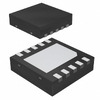Manufacturer Part Number
LM2748MTCX
Manufacturer
Texas Instruments
Introduction
The LM2748MTCX is a monolithic, high-speed pulse-width-modulation (PWM) controller for a power-efficient DC to DC buck converter.
Product Features and Performance
High-frequency operation from 50kHz to 1MHz
Supports step-down (buck) topology
Transistor driver output type
Single output phase with maximum 86% duty cycle
Integrated synchronous rectifier for improved efficiency
Frequency synchronization capability
Current limit, enable, frequency control, power good, soft start, and tracking control features
Safely operates at a temperature range of -40°C to 125°C
Product Advantages
Highly efficient power conversion
Versatile frequency adjustment for diverse applications
Precision enabling and power monitoring for reliable operation
Thermal regulation for safety and performance
Key Technical Parameters
Voltage - Supply (Vcc/Vdd): 3V ~ 6V
Single output configuration
Output: Positive polarity
Topology: Buck Converter
Number of Outputs: 1
Duty Cycle (Max): 86%
Synchronous Rectifier: Yes
Clock Sync: Yes
Control Features: Include various modulation and safety features
Operating Temperature Range: -40°C ~ 125°C
Quality and Safety Features
Built-in current limit protection
Soft start function to prevent power surge
Thermal shutdown capability
Robust design with an extended operating temperature
Compatibility
14-TSSOP surface mount package
Compatible with a variety of power management applications
Application Areas
Various electronic devices requiring efficient power conversion
Portable and battery-powered equipment
Industrial and telecommunications systems
Product Lifecycle
Product Status: Obsolete
Potential for replacements or upgrades subject to Texas Instruments' current offerings
Several Key Reasons to Choose This Product
Wide input voltage range catering to different power sources
High-efficiency design to conserve battery life
Flexible control features enabling precise power management
Robust construction for harsh environmental conditions
Obsolete status may favor legacy systems in need of compatible components


 LM2743QMTCNS/TI
LM2743QMTCNS/TI LM2750LD-5.0/NOPBTexas Instruments
LM2750LD-5.0/NOPBTexas Instruments LM2750LD-5.0Texas InstrumentsIC REG CHARGE PUMP 5V 10WSON
LM2750LD-5.0Texas InstrumentsIC REG CHARGE PUMP 5V 10WSON LM2750SD-5.0Texas InstrumentsIC REG CHARGE PUMP 5V 10WSON
LM2750SD-5.0Texas InstrumentsIC REG CHARGE PUMP 5V 10WSON